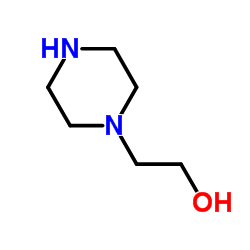HEPES sodium salt

HEPES sodium salt structure
|
Common Name | HEPES sodium salt | ||
|---|---|---|---|---|
| CAS Number | 75277-39-3 | Molecular Weight | 260.286 | |
| Density | N/A | Boiling Point | N/A | |
| Molecular Formula | C8H17N2NaO4S | Melting Point | 234ºC | |
| MSDS | USA | Flash Point | N/A | |
Use of HEPES sodium saltHEPES sodium, a nonvolatile zwitterionic chemical buffering agent, is broadly applied in cell culture. HEPES sodium is effective at pH 6.8 to 8.2. HEPES sodium is also a potent inducer of lysosome biogenesis[1][2][3]. |
| Name | sodium 2-[4-(2-hydroxyethyl)piperazin-1-yl]ethanesulfonate |
|---|---|
| Synonym | More Synonyms |
| Description | HEPES sodium, a nonvolatile zwitterionic chemical buffering agent, is broadly applied in cell culture. HEPES sodium is effective at pH 6.8 to 8.2. HEPES sodium is also a potent inducer of lysosome biogenesis[1][2][3]. |
|---|---|
| Related Catalog | |
| In Vitro | HEPES maintains superhydrophilicity of titanium for at least 3 months and resulted in a continuous retention of bioactivity and osteoconductivity[1]. HEPES drives lysosome biogenesis, affects MiT/TFE cytoplasmic-nuclear distribution, disrupts global cellular transcriptional profiles, resulting the activation of a MiT/TFE-dependent lysosomal-autophagic gene network in cultured RAW264.7 cells[3]. |
| References |
[2]. Sledź P, et al. An experimental charge density of HEPES. Acta Crystallogr B. 2010;66(Pt 4):482-492. |
| Melting Point | 234ºC |
|---|---|
| Molecular Formula | C8H17N2NaO4S |
| Molecular Weight | 260.286 |
| Exact Mass | 260.080658 |
| PSA | 92.29000 |
| Storage condition | Store at RT. |
| Stability | Stable. Hygroscopic - protect from moisture. Incompatible with strong oxidizing agents. |
| Water Solubility | H2O: 1 M at 20 °C, clear, colorless |
| Precursor 2 | |
|---|---|
| DownStream 0 | |
| HS Code | 2933599090 |
|---|---|
| Summary | 2933599090. other compounds containing a pyrimidine ring (whether or not hydrogenated) or piperazine ring in the structure. VAT:17.0%. Tax rebate rate:13.0%. . MFN tariff:6.5%. General tariff:20.0% |
|
[Permeability of pannexin 1 channels to large anions].
Ross. Fiziol. Zh. Im. I. M. Sechenova 98(12) , 1578-86, (2012) It is widely accepted that ATP secretion in diverse cells involves pannexin 1 (Panx1) that functions as an ATP-permeable channel. We analyzed the permeability of Panx1 channels heterologically express... |
|
|
Factor VIII organisation on nanodiscs with different lipid composition.
Thromb. Haemost. 113(4) , 741-9, (2015) Nanodiscs (ND) are lipid bilayer membrane patches held by amphiphilic scaffolding proteins (MSP) of ~10 nm in diameter. Nanodiscs have been developed as lipid nanoplatforms for structural and function... |
|
|
Environmentally persistent free radical-containing particulate matter competitively inhibits metabolism by cytochrome P450 1A2.
Toxicol. Appl. Pharmacol. 289 , 223-30, (2015) Combustion processes generate different types of particulate matter (PM) that can have deleterious effects on the pulmonary and cardiovascular systems. Environmentally persistent free radicals (EPFRs)... |
| 1-Piperazineethanesulfonic acid, 4-(2-hydroxyethyl)-, sodium salt (1:1) |
| HEPES sodium salt |
| EINECS 278-169-7 |
| Sodium 2-[4-(2-hydroxyethyl)-1-piperazinyl]ethanesulfonate |
| MFCD00036463 |
| 1-Piperazineethanesulfonic acid, 4-(2-hydroxyethyl)-, monosodium salt |
 CAS#:103-76-4
CAS#:103-76-4 CAS#:1562-00-1
CAS#:1562-00-1
